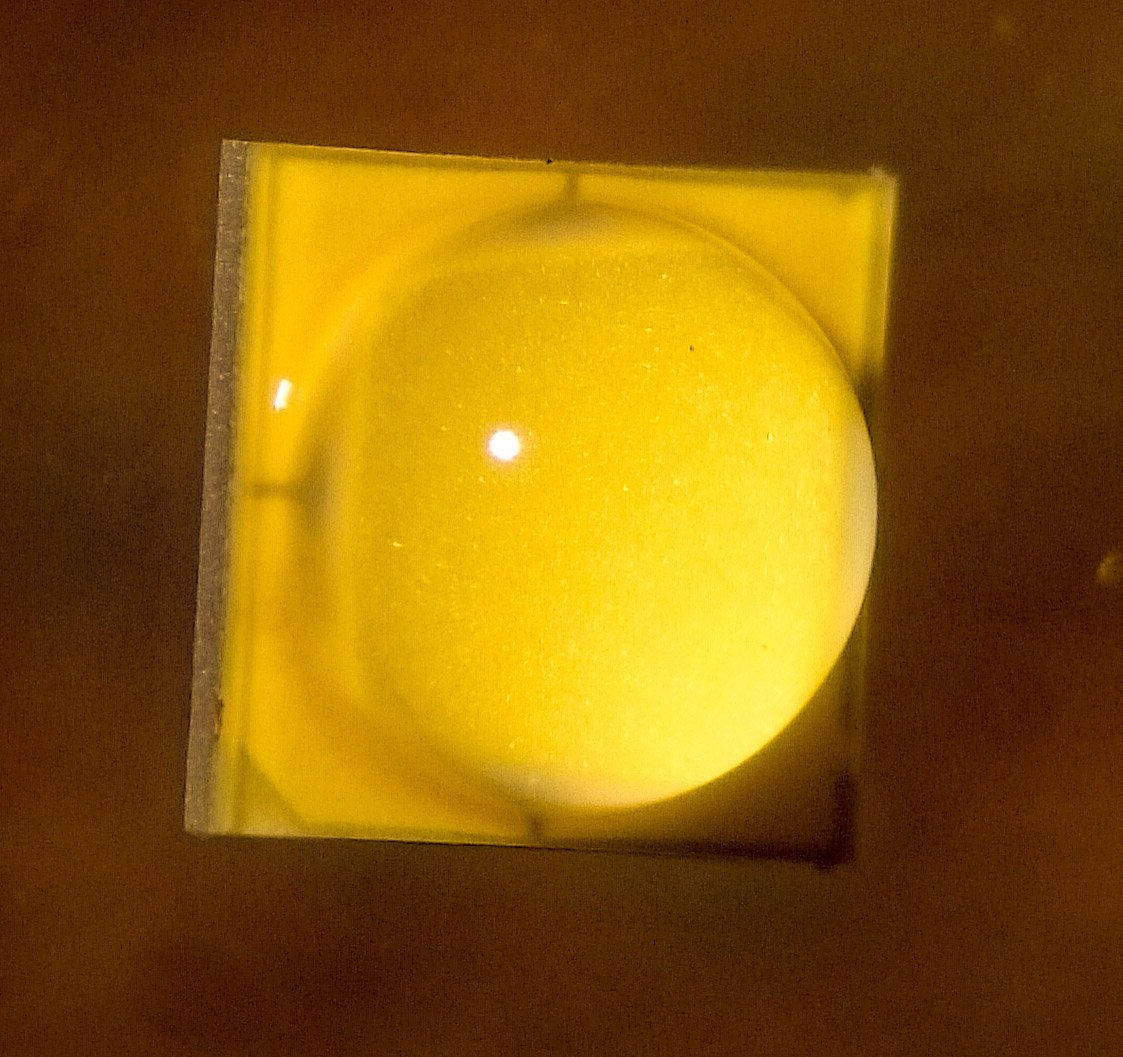
It has been a long time since Lumileds released an emitter that was really appealing for flashlight use. In fact, ever since Cree smashed all prior existing performance with the introduction of the XR-E, the Luxeon leds never took the lead again. The tints (at same CRI) of the Luxeons were always good, and superior (IMO) to the Cree leds, but the performance lagged behind. So how about the new Luxeon V ? (confusingly there already used to exist a Luxeon V led in the old days, it is a bit of a mystery that Lumileds chose an existing name this new led).
The Luxeon V is a new high power single die white led from Lumileds that has a similar footprint shape as the Cree XP and XM leds but in size it is in between those. The specifications are quite remarkable (specs), rated for almost 5A and 1700 lumen (which is similar to the Luminus SST-40) but with a thermal resistance of 0.8 degC/W, which is 3 times as low as any existing high power led. For the moment it only comes in 70 CRI (same story as the SST-40) and in 3000, 4000, 5000, 5700 and 6500K
I bought 5 pieces of the 4000K 70CRI Luxeon V leds from Mouser (they also have 6500K but no other colour temperatures as yet) and put one to the test and used one for a mod in a Thorfire VG10. The price was modest ($3.63 a piece ex VAT) but as usual I had to buy several extra leds (![]() ) to get to the free shipping threshold.
) to get to the free shipping threshold.
Before buying, by examining the specs, I knew that the footprint would become problematic for there is no existing ledboard out there fitting it. But I reckoned by inspecting the dimensions that I would by a hair get away with a XP-board. This would of course not show the full thermal potential of the Luxeon V. Upon receiving the leds I could see how close the led is to not fitting:
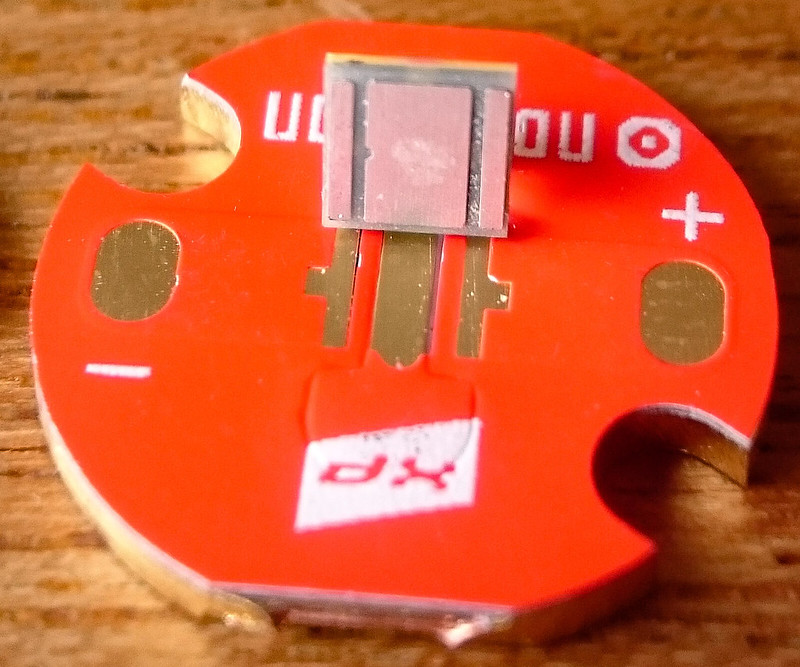
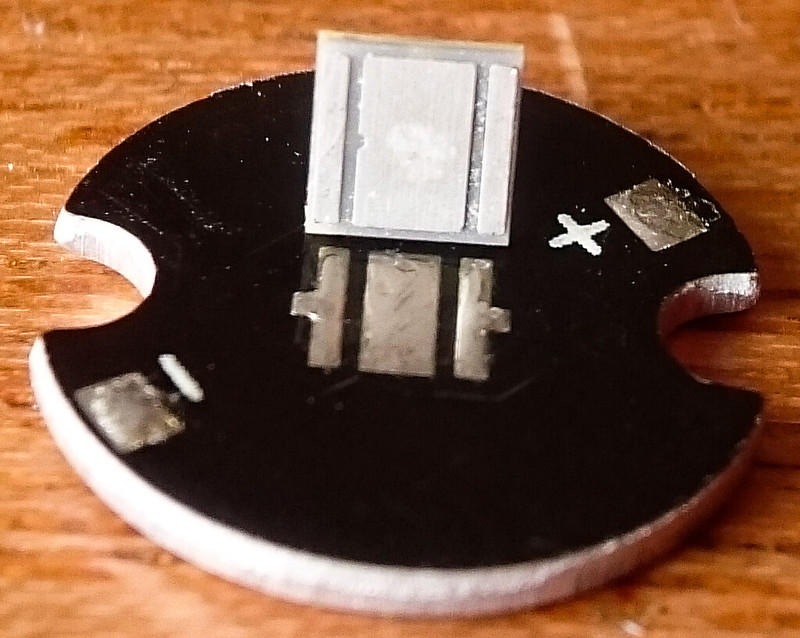
It could by just work on a Noctigon, but I have some other XP boards in my junk-box that probably would not work.
So this was one of the most careful reflows ever, correcting the led on the Noctigon many times until it was exactly centered on the solder pads, trying to use enough solder paste to fully cover the central pad but not too much because the trick of squeezing out excess solder only works for well fitting leds. The result was not perfect but would have to do:
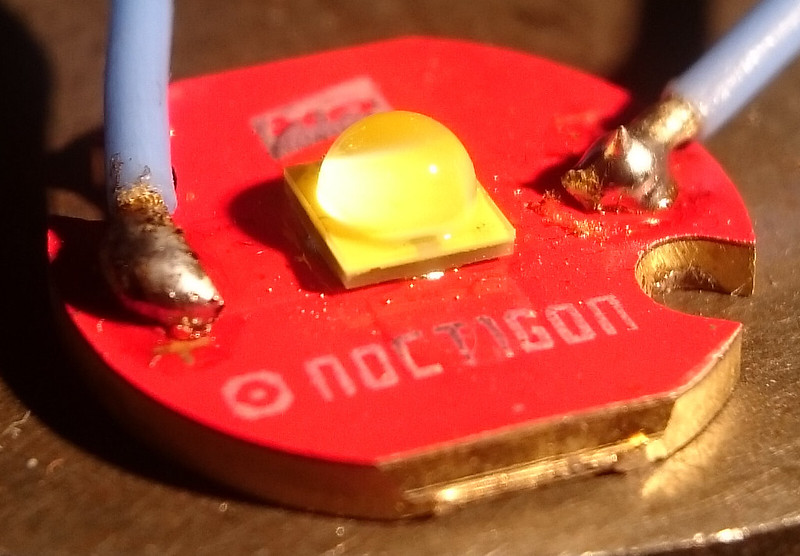
The led is slightly lifted on the side visible in the picture, but the backside is tight on the board. This will have to do for the test.

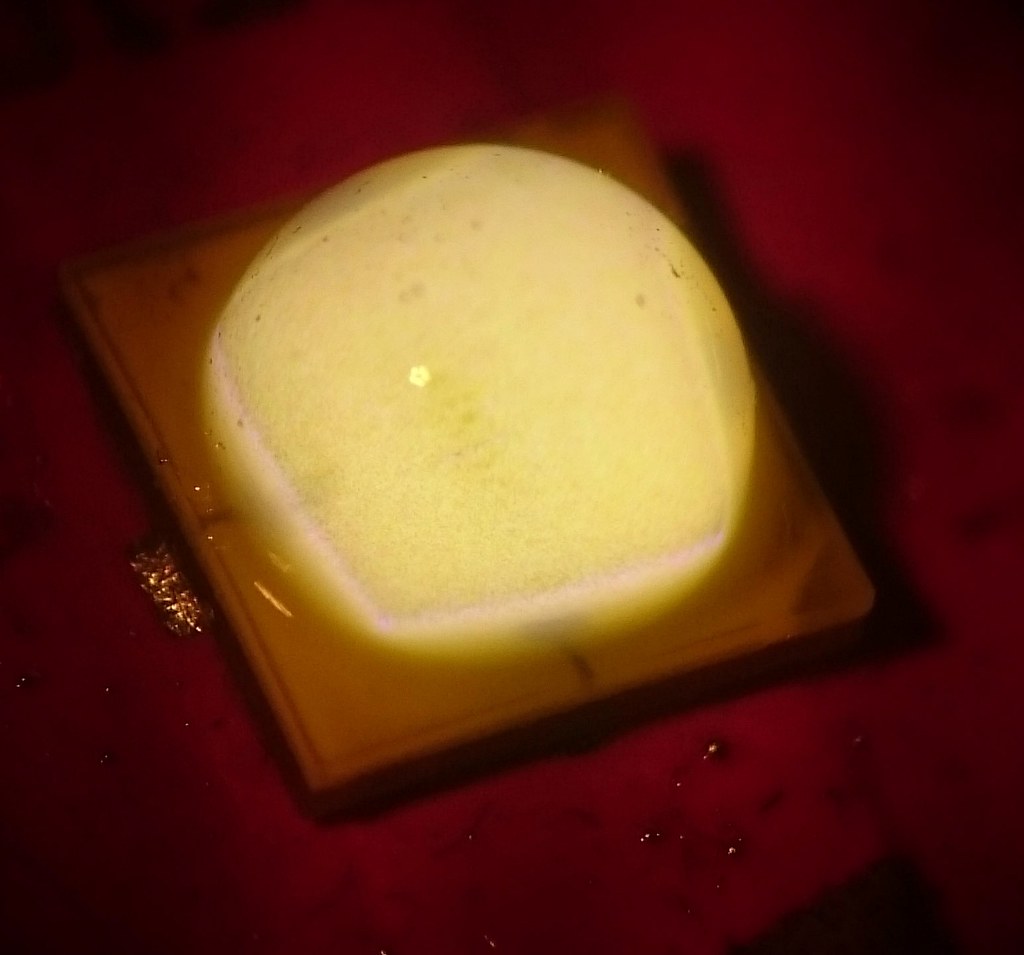

So it does light up on a XP-Noctigon (few mA in the picture) while keeping the core of the board electrically neutral, and as you can see the apparent die size is similar to the XP-L led. The phosfor seems a bit damaged in the middle and I'm not surprised because I took the pictures after the test. ![]()
On to the test...
The test was done like all my more recent emitter tests. I described it in detail in my XP-L test. , with two minor differences that should not matter significantly for the results: I used my Integrating sphere no. II instead of no. I, and for the current I used a clamp meter, which appears to measure 0.1A lower than the power supply current-reading that I used before.
In summary: 1) just one led was tested, reflowed on a DTP copper board (XP-Noctigon 16mm diameter), 2) I used my large version II integrating sphere with high quality luxmeter, 3) the output numbers and voltages were measured with the led close to 'steady state' for each current, so warmed up and settled, you should be able to get these numbers in a well heatsinked flashlight. Mind that these are output numbers of the bare led, in a flashlight there will be losses from light obstructions, lens and optic, 4) output is in 'djozz-lumen' defined as 1/550 of the output of my Sunwayman D40A on high setting, which I hope is close to the real lumen, but at least is consistent over all my emitter tests done in integrating spheres. (my recent comparison with maukka's sphere shows that the djozz-lumen is 5-11% high compared to his fully calibrated set-up, but I keep using the djozz-lumen because it is consistent over all my led- and flashlight tests and thus makes comparison easy)
Here's the results. I took my earlier SST-40 N4 bin data for comparison because that is the best performing led in this class that I have tested before. I would have liked to include XP-L2 data but I have never tested it so I do not have data at hand, please refer to Texas Ace's XP-L2 test for that, the performance seems a bit lower than the SST-40 and Luxeon V.
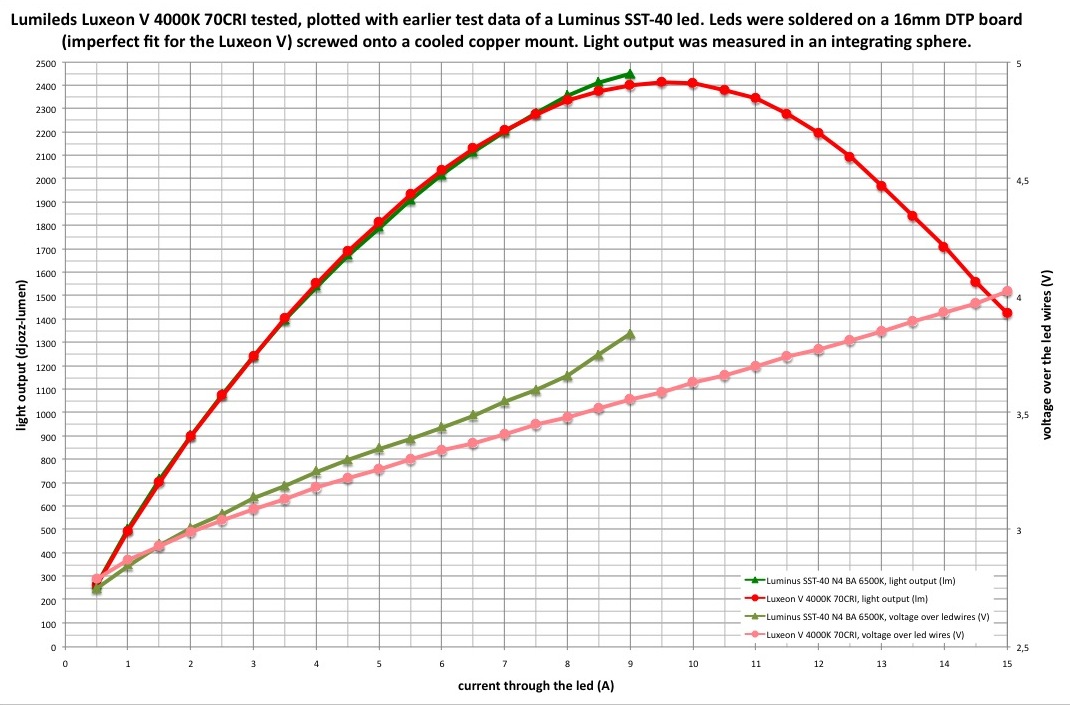
What can be seen?
- On this ledboard, the current to output performance of the Luxeon V is almost exactly that of the SST-40 in N4 bin, but because the voltage is lower, especially at high currents, it is more efficient. This higher efficiency will however not be obtained in a flashlight with lineair driver (like a 7135-based current controlled driver) because any voltage difference is burnt off by the driver. The very low voltage does increase the current in direct drive flashlights, which will or will not be an advantage; it may be too high for comfort/safety or will cause a decreased efficiency, especially of course if the current is higher than 9.5A at which current the light output maxes out.
- We do not know yet how this led will perform on a dedicated DTP-board. Somehow I think that the difference will not be great, but I can be wrong, only a test will tell.
- Like the XP-L2 (but unlike the SST-40 that burnt its bond wires at 9.5A), this led survives high current at least up to 15A, without loss of performance afterwards. I had the led at 15A for two minutes, and after cooling down, the performance at 6A was just 2% less than before. Even at 15A I did not see an obvious tint shift to blue, like what usually happens when severely overdriving leds. I did see some slight irregularity in the phosfor afterwards (see picture above), that was perhaps not present before the test (did not check).
A mod.
Now that we know that the Luxeon V has very good performance but does not stand out way above its competitors (at least not when reflowed on a XP-board, on a dedicated board it may be different), how are the other parameters that determine how well a led performs in a flashlight: tint, beam, does it dedome? That will require a mod!
I did a mod in a Thorfire VG-10 (the good type) with a BLF-A6 direct driver. Because this led has the lowest voltage of them all, I expect to get this led easily to 9.5A and its maximum output, perhaps even more. I used a VG10, a Luxeon V led, a 20mm Kaidomain DTP-XP board, a BLF-A6 driver with short 20 AWG ledwires, 20AWG bypassed driver-spring, phosfor bronze (djozz-) tail-spring, PD68 low resistance switch-board, small omten switch. The ledboard-shelf was a tiny bit hollow (better than convex!) but the ledboard is 20mmx1.6mm copper so heat-shedding to the shell should still be ok (with help of a generous layer of Arctic Silver ![]() ). I had a led centering piece of which the outside was too wide for the reflector and the inside too narrow for the 4x4mm led, so the reflector hole and the centerpiece hole were reamed to fit; advantage was perfect fit and centering.
). I had a led centering piece of which the outside was too wide for the reflector and the inside too narrow for the 4x4mm led, so the reflector hole and the centerpiece hole were reamed to fit; advantage was perfect fit and centering.
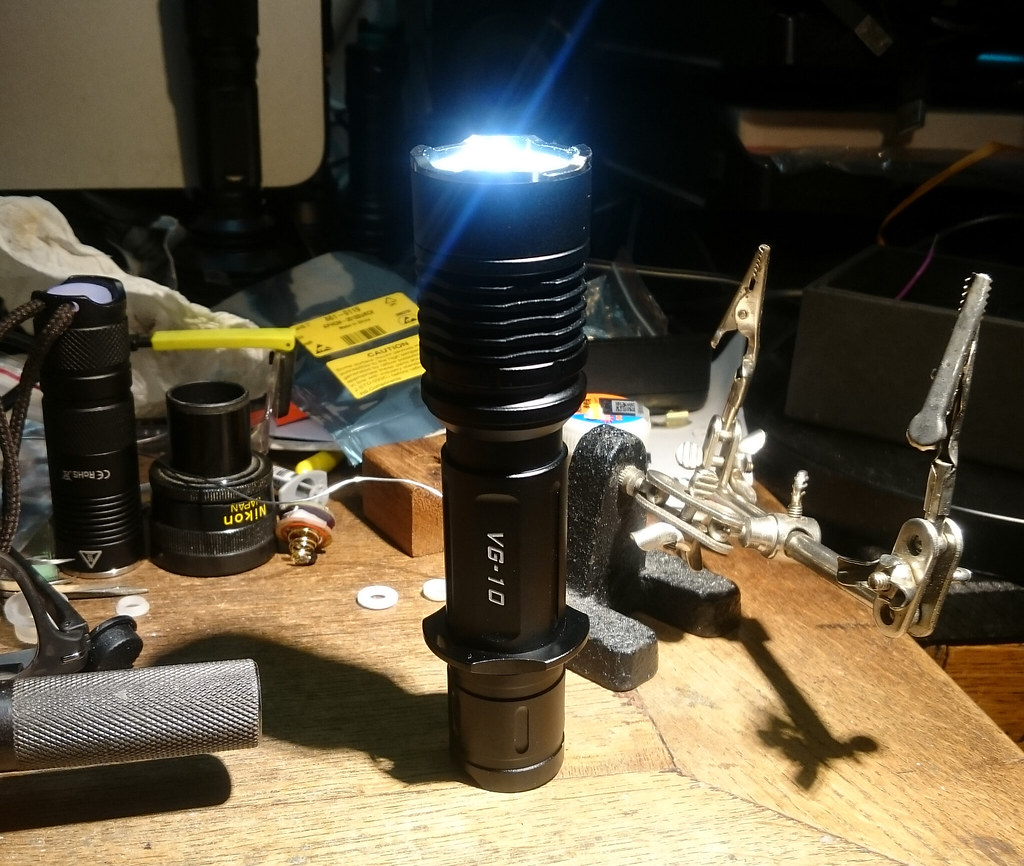
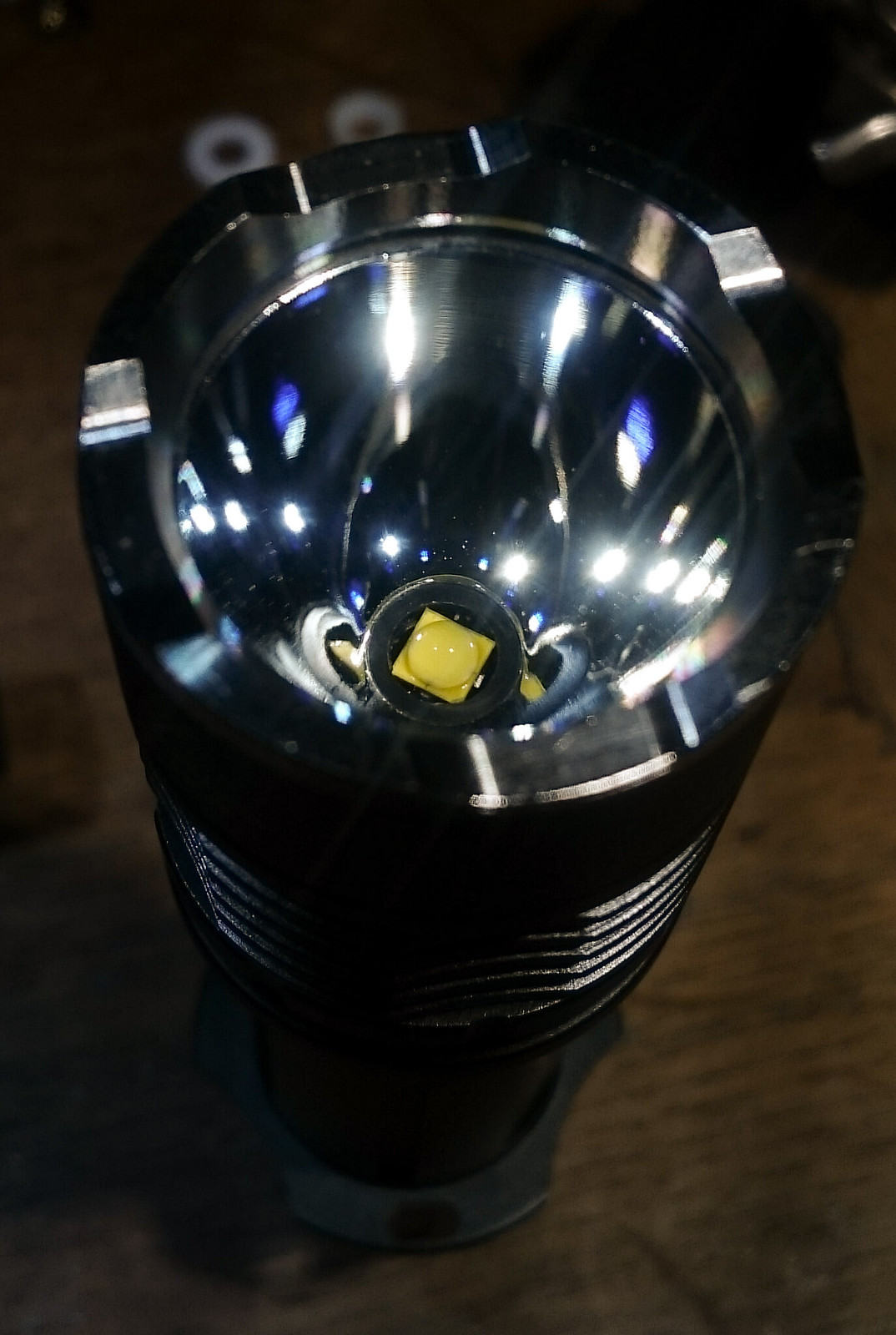
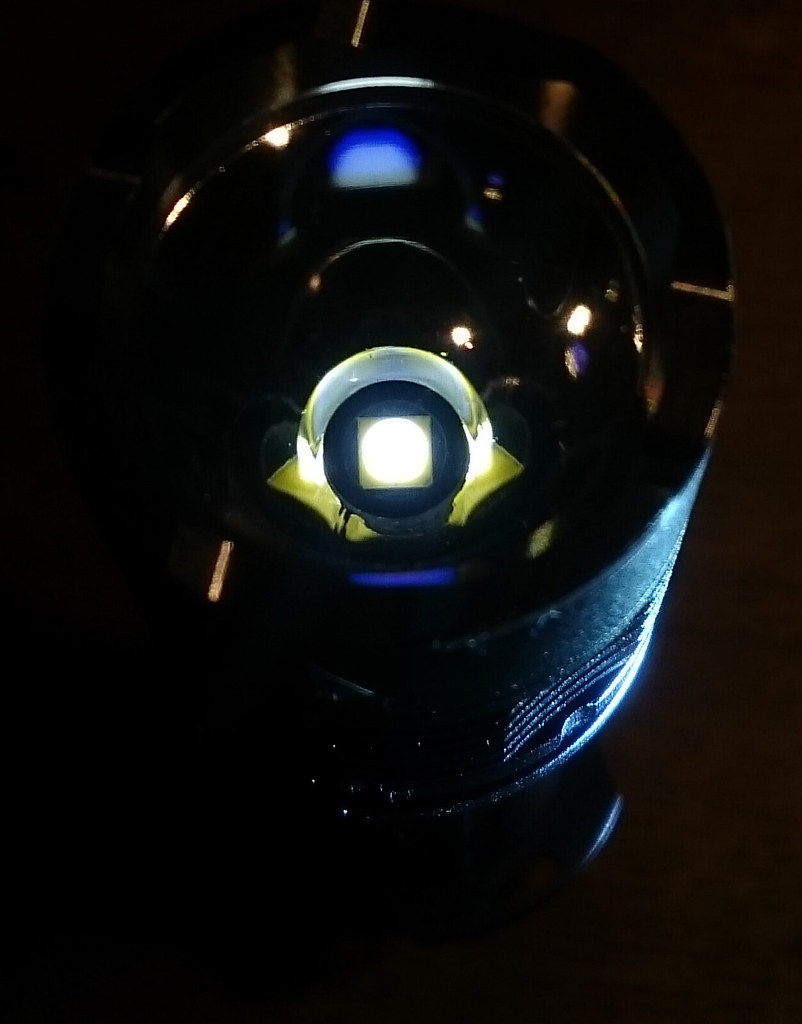
So now some real world performance could be found. First the numbers at maximum output on a freshly charged Sony VTC6 battery: current with tail-off measured with a tick copper loop and clamp meter: 9.5A, output at start 2170 lm, output at 30 seconds 2015 lm. Not shabby, is this the best output ever for a single-die-led-single-18650 flashlight? Throw at 30 seconds was 30 kcd. Then the beam and tint:

The beam is really good, quite a few new high output leds (Cree) have huge tint variation over the beam, while the luxeon V has a very pleasant beam with little tint variation, one of the best beams I have seen (apart from a slight ring out in the spill not caused by the led but by the shiny VG10 bezel).
The tint is also really good. I can just judge the 4000K version, but it is the best 4000K tint that I have seen, with the right amount of yellow and rosy in it (you could always trust Lumileds for good tints!). I would choose the light of this led over the light of many higher CRI leds. Of course the reds are more orangy than the light from a 90 CRI Nichia, and wood tints are more yellow, but that is what you get at 70 CRI.
I have not tried to dedome the led. The way the construction of the led looks (seems like a flip-chip design) I expect dedoming it will not be as easy as the old Cree's and the SST-40, and the result may disappoint (see for an interesting read the experiments and discussion from EasyB here). So I leave dedoming attempts to others this time, moreover because I'm not that good at it.
Conclusion and thoughts.
The Luxeon V for now seems not made for throwers but other than that, for its sheer output, toughness, tint and optical behaviour I think in the single die category it is the best out there, even when reflowed on a non-fitting XP-board. I hope that someone (not me this time) will have a batch of dedicated DTP-boards made for the Luxeon V by Kerui Electronics (BLF-member leo ou (Sundy) is the representative), so we can really find out what this led is capable of. It makes an obvious Q8 mod too, the reflow on the XP-pads will require precision and the centering pieces need reaming a bit, but then you have an instant 8000 lumen (and a ridiculous amount of heat ![]() )
)
Thanks for reading!
EDIT oct 8 2017: Good news, Led4power has made and sells a dedicated 16mm DTP-board for the Luxeon V ![]() , see post #31 and www.led4power.com. I have tested this board, result in post #73.
, see post #31 and www.led4power.com. I have tested this board, result in post #73.